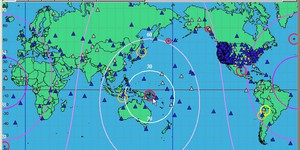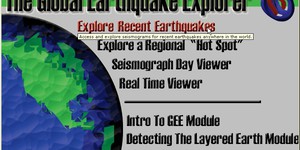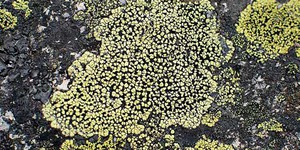Twelfth Grade, Geology Science Projects (7 results)
Geologists study the Earth, trying to understand the forces that gradually shape and change the landscape and ocean floor, as well as forces that make themselves felt more suddenly, like earthquakes and volcanoes. The information geologist discover helps in many ways, from keeping populations safe from disasters like landslides to uncovering important ore deposits like titanium used for surgical equipment.
|
Select a resource
Sort by
|
How is geology important for our energy resources? Coal, oil, and natural gas are formed by geological processes over millions of years. Certain geological formations can indicate a reservoir of coal, oil, or natural gas. Also, geothermal processes can be used as an energy resource. How are these formations identified? How are the resources extracted? You can use the National Geospatial Program to access, view, and download information from geospatial databases containing a broad spectrum…
Read more
Featured
Have you heard that garlic powder is supposed to inhibit the growth of bacteria? Which do you think would make a better disinfectant: a solution of garlic powder or a solution of bleach? This project shows you a straightforward way to compare the effectiveness of different disinfectants (or other antimicrobial agents), by measuring zones of inhibition on a culture plate.
Read more
When an earthquake happens, how are scientists able to determine the original location of the quake? In this project, you'll use archived data from a global network of seismometers to find out for yourself. You will make your own seismograms using the Global Earthquake Explorer program, and then use the seismograms to determine the location of earthquake epicenters.
Read more
New
Have you ever noticed that on a hot day, it's more comfortable to wear a light-colored shirt than a dark one? Or that it's cooler in a park than walking down a street? This happens because different surfaces absorb and reflect heat in different ways. Urban heat islands are parts of cities where man-made surfaces like pavement and buildings replace natural surfaces like grass and trees. In this project, you will use temperature and satellite data to see if certain areas in a city have higher…
Read more
When an earthquake occurs, seismic shock waves travel out through the earth from the source of the event. The shock waves travel through the earth or along the Earth's surface, and can be recorded at remote monitoring stations. Some of the waves that travel through the earth are blocked or refracted by the Earth's liquid core, which means that monitoring stations located certain distances from the earthquake do not detect these waves. This creates a "seismic shadow" that you can use to…
Read more
You can study hazards that affect coastal areas. What geological forces cause a tsunami? A tsunami (Japanese for 'harbor wave') is a wave generated by an undersea earthquake, landslip, or volcanic eruption. You can demonstrate what causes a tsunami by simulating an undersea earthquake with a water table. How does the depth of water effect the height of the wave? Do different slopes of bottom change the speed of the wave? Visit the USGS Coastal and Marine Geology Program to find out about…
Read more
Have you ever noticed an old stone wall and wondered how long it has been there? If there is lichen growing on the wall, the lichen has most likely been living there since the time the wall was made, so if you could figure out how old the lichen is then you could deduce the age of the wall. Geologies use this method, called lichenometry, and other methods to establish dates and temporal sequences as they seek to construct a history from the available evidence. In this geology science project,…
Read more
New
Artificial intelligence (AI) programs can now generate photorealistic pictures of people who do not exist in the real world. How can you tell if a picture is of a real person or a fake, AI-generated person? What features of the picture do people use to decide whether the face is real or AI-generated? In this project, you will explore these questions as you ask volunteers to look at both real and AI-generated pictures of human faces.
Read more
Did you know that waves travel through the Earth's crust all the time? One major source of these waves is earthquakes, although ground motion can also be caused by something man-made, such as a mine blast or nuclear explosion, or other natural events, such as landslides or volcanic activity.
How does an earthquake cause these waves? The entire outer shell of the Earth, known as the lithosphere, is made up of tectonic plates that are constantly moving. There are seven or eight large…
Read more
Think about mountain ranges, canyons, sand dunes, or any other interesting geological feature you may live near enough to visit. The surface of the Earth is always changing due to a balance of forces both above and below the surface. Below-surface forces cause the Earth's crust to be faulted, folded, tilted, and lifted. Above-surface forces are primarily due to the natural processes of weathering and erosion. Can you show the effects of these forces using scale models, demonstrations,…
Read more
|
Explore Our Science Videos
Brazil Nut Effect Explained
Make Your Own Lava Lamp
Make Candy Gears - STEM activity










